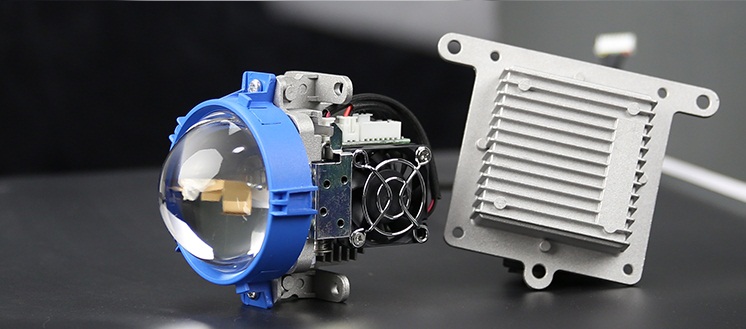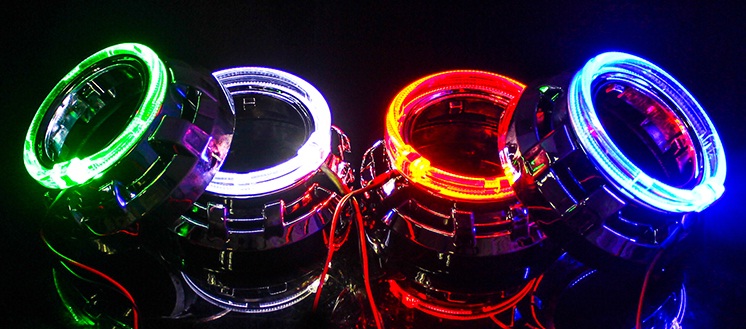Being blinded by an oncoming car`s high beams — or failing to see deer about to cross the road because of too-dim low beams — soon could be problems of the past.
Advanced headlight systems with adaptive driving beams are expected to light U.S. roadways, possibly in the next year. The so-called `glare-free high-beam systems` have the ability to automatically spotlight specific areas of the road while driving.
`It`s safety, safety, safety,` said Gavin Warner, who oversees research and development in North America for Valeo Lighting Systems. `It really allows the driver to have a more comfortable vision when they`re driving and allows them to see obstacles that would normally be hidden left and right of the vehicle because you`re just on low beam.`
For rear-approaching and oncoming cars, it avoids the glare many drivers experience when another motorist has high beams on. Warner called it `safety and comfort for everybody.`
A forward-facing camera senses other traffic, and the car`s computer controls beam patterns to maximize lighting while reducing glare. Many of the new systems use a matrix of LED lights that modulate based on need: When oncoming traffic is recognized, the system may tell the headlight to dim only the diodes on the far left of the driver`s-side headlight while keeping the high beams on the rest of the roadway. When approaching another car from the rear, diodes in the center of the lighting field dim automatically while they stay at full intensity on the margins.
 Adaptive driving beam systems have been in the works for years. Several automakers already have launched them in Europe after regulators gave the OK in 2013.
Adaptive driving beam systems have been in the works for years. Several automakers already have launched them in Europe after regulators gave the OK in 2013.
Officials with the National Highway Traffic Safety Administration and Society of Automotive Engineers lighting committee will meet this week to try to set standards for new regulations in the United States.
`We want to get a clear direction if anything additional has to be changed ... and how can we proceed to measure the use of the system in the U.S.,` said Rainer Neumann, Varroc Lighting Systems GmbH`s vice president of global technology. `This is something we are thinking is the future for all vehicles.`
Neumann, whose company was formerly part of Visteon Corp., said he hopes regulators finalize the new standards by early 2017.
NHTSA spokesman Bryan Thomas confirmed that federal officials are continuing to work on regulations. He declined to give a target date.
`Both (U.S. Secretary of Transportation Anthony) Foxx and (NHTSA Administrator Mark) Rosekind have spoken out about the need to identify and remove potential regulatory hurdles to safety improvements,` he said in an email to The Detroit News. `To that end, the agency has conducted research on adaptive headlighting and is moving to take actions to permit this innovative safety technology.`
Regulatory red tape keeps the advanced lighting off U.S. roadways today: Current law outlines low- and high-beams as separate systems with specific standards of brightness and beam coverage. Adaptive driving beam systems are essentially a hybrid and don`t fit current regulations.
NHTSA has indicated a willingness to update the lighting regulation to include adaptive driving beams. It also has indicated that recommended engineering practices be established with the SAE.
The federal automotive safety organization last summer released a 201-page assessment of adaptive driving beam systems being used in Europe and other areas. NHTSA found the systems were `shown to have the ability to dynamically adapt the headlamp beams to shade oncoming and preceding vehicles.`
However, in many cases lighting levels exceeded that of lower-beam mode in the presence of other traffic. In particular, they had trouble dimming sufficiently around curves and at intersections. Some also were unable to dim for motorcycles.
The expected regulation changes follow a recent study from the Insurance Institute for Highway Safety that found many headlights currently on U.S. roadways underperform. The industry-funded organization tested headlights of more than 30 midsize cars. Only one model was rated `good.` About a third were rated `acceptable,` a third `marginal` and a third `poor.`
The downside of the new lighting systems is the same as most advanced safety features: cost. A camera is required and more lights are needed, and that costs money. However, as cameras increasingly become integrated into other safety systems, experts expect the cost will go down.
Warner said he hopes new regulations are finalized by late 2017 for the lighting to be implemented for model-year 2018.
Valeo offers seven adaptive driving beam systems, including some that move or rotate based on the direction the car is going. The headlights essentially swivel with the car`s steering to help see around curves.
However, Warner and Neumann say the newer `fixed` systems are really what they see being used the most in the future because they reduce complexity.
`It`s a great safety feature, it`s so comfortable to drive in,` Warner said. `Especially in the U.S., where you have a lot of people driving in the country and wide roads with a lot of wildlife out there, I think it`s very, very helpful.
`This system will not just be safe for the end-user, the driver, but also allow you to detect those obstacles on the side of the road that are hidden today.`




